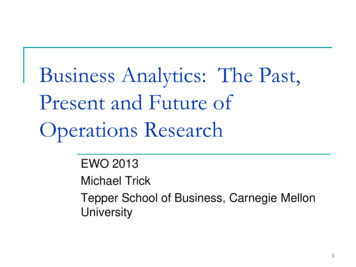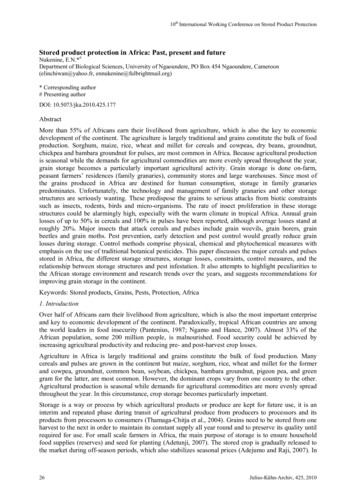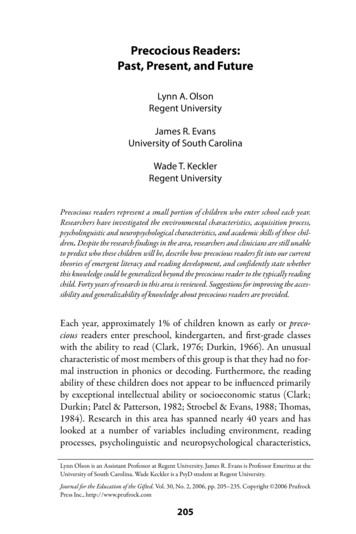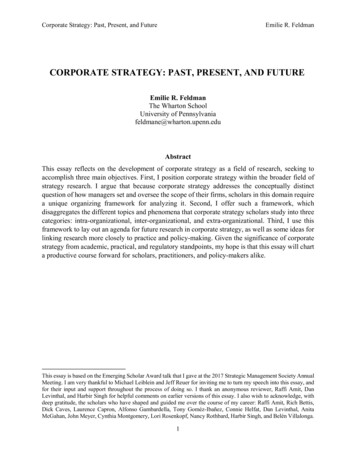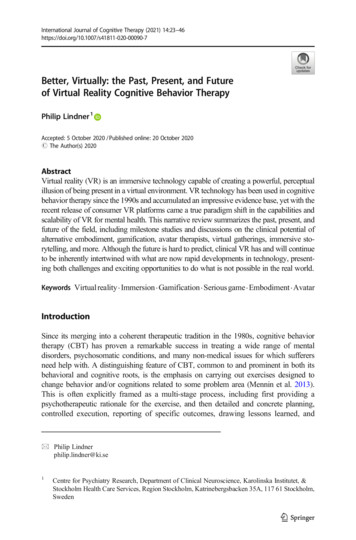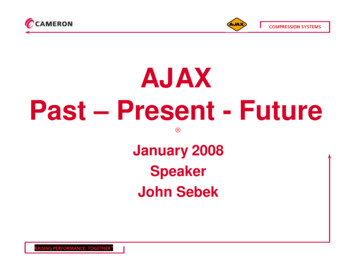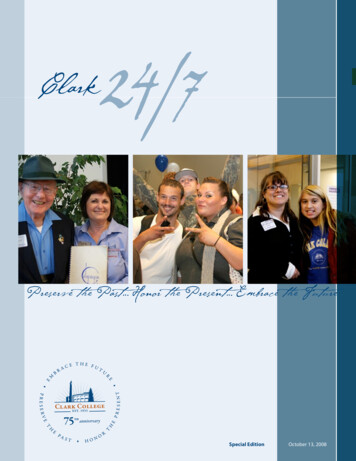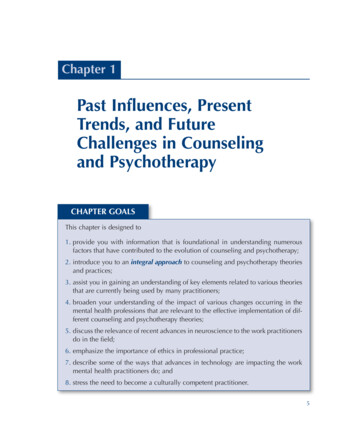
Transcription
Chapter 1Past Influences, PresentTrends, and FutureChallenges in Counselingand PsychotherapyCHAPTER GOALSThis chapter is designed to1. provide you with information that is foundational in understanding numerousfactors that have contributed to the evolution of counseling and psychotherapy;2. introduce you to an integral approach to counseling and psychotherapy theoriesand practices;3. assist you in gaining an understanding of key elements related to various theoriesthat are currently being used by many practitioners;4. broaden your understanding of the impact of various changes occurring in themental health professions that are relevant to the effective implementation of different counseling and psychotherapy theories;5. discuss the relevance of recent advances in neuroscience to the work practitionersdo in the field;6. emphasize the importance of ethics in professional practice;7. describe some of the ways that advances in technology are impacting the workmental health practitioners do; and8. stress the need to become a culturally competent practitioner.5
6—PART I AN INTEGRAL APPROACH TO COUNSELING AND PSYCHOTHERAPY**VIGNETTE #1James is a 25-year-old, African-Americancollege student who seeks counseling becauseof his “problems with keeping friends.” In hisinitial therapy counseling session, James indicates that he has an “anger problem” thatcontributes to losing connections with variousfriends in his life. James is particularly concerned about the problems he has in maintaining friendships with women and his coworkers in the organization where he is employed.In his first therapy session, James explainsthat he commonly develops a friendly relationship with people only to find himselflosing his connections with these personswhen he expresses frustrations and “blows”up with them. Although it appears that Jamesis not a physical threat to other people, he andhis counselor agree that the issue of angerneeds to be addressed in their therapeuticmeetings together. James also states that whilehe has doubts about the benefits that mightbe derived from counseling, he is willing to“give it a shot.”As you will see on reading this chapter,there are many different ways counselors andtherapists can help James work on his angerproblem, depending on their theoretical orientation. Additional vignettes will be presentedat the start of each chapter and used as a pointof reference to illuminate different aspects ofthe counseling and psychotherapy theoriescovered in this textbook.**INTRODUCTIONThe development and implementation ofcounseling and psychotherapy theories haveundergone a host of evolutionary changesover time. These changes are stimulated bymany factors. One of the obvious factors thatcontributes to the evolutionary changes occurring in counseling and psychotherapy is thevarious persons who have developed differenthelping theories, which mental health professionals have routinely put into practice overthe past 100 years.The implementation of these theoreticalperspectives in our professional practices helpsclients realize untapped aspects of their humanpotential. By using different theories of counseling and psychotherapy in this way, mentalhealth practitioners have been able to assistcountless numbers of people in developingmore effective, satisfying, and productive waysof living (Distelberg, 2008; Shedler, 2010;Wampold, Lichenberg, & Waehler, 2002).Three major theoretical forces have dominated the work of counselors and therapists inthe past. These include the three original andmost practiced forms of helping—the psychodynamic (first force), cognitive-behavioral(second force), and existential-humanistic(third force) theories of counseling and therapy. These key theories form the first majortheoretical discussions in this book.Newer theories have evolved and arebecoming more central, and you will find thatmost practitioners draw on these ideas consistently and integrate them in their interviews,even if operating from other theoreticalapproaches. First among these is multiculturalcounseling and therapy, often called the fourthforce in helping. In addition, it is now important to understand and become skilled in othernewer approaches. Important among theseare feminist, narrative, positive psychology/wellness, solution-focused, motivational interviewing, interpersonal, and developmentalcounseling and therapy. Beyond that, family
Chapter 1 Past Influences, Present Trends, and Future Challenges—7therapy is increasingly being recognized for itscontribution to individual work as well as tothe family. Research and clinical experiencesupport these systems, and effective counselors and therapists will want to make many ofthese strategies part of their practices.Numerous societal factors have contributed to the ongoing evolution of counselingand psychotherapy. These include the rapiddemographic transformation of society, whichhas underscored the need for counselors andtherapists to develop and implement newcompetencies in their work.New developments in our professionalorganizations have also impacted the waypractitioners think about and implement various counseling and psychotherapy theoriesand practices. These professional developments include revisions in our ethical standards, increasing use of the Diagnostic andStatistical Manual of Mental Disorders(American Psychiatric Association, 1994),and a growing emphasis on the importance ofusing evidence-supported therapies whenaddressing clients’ problems.Unprecedented advances in science andtechnology, including exciting new developments in neuroscience and the use of computer-based resources, represent other factorsaffecting our collective thinking about waysto promote clients’ development, psychological wellness, and mental health. Clearly, allthese issues are important to consider whenthinking about the evolution of counselingand therapy theories and practices.Too often, however, students and practitioners in the mental health professions fail toconsider the interdependent nature of thesefactors when thinking about the theoreticalapproaches they will ultimately use in theirwork. The failure of many practitioners toconsider the above mentioned factors whendeveloping their approach to counseling andpsychotherapy is understandable given the lackof a comprehensive framework that effectivelyaddresses these and other related variables.Although this situation is understandable,it is lamentable for a couple of reasons. First,the lack of a comprehensive model that wouldhelp students and practitioners develop anintegrated understanding of such factors oftenleads to fragmented thinking about theseissues. The following questions commonlyresult from such fragmented thinking: How do I decide when to use differenttheories of counseling and psychotherapy with my clients? What competencies do I need to acquireto work effectively and respectfullywith culturally different clients? How do psychological, biological/neurological, cultural, and societal factors impact clients’ functioning and mydecision to use particular theoreticalapproaches in therapy? What does it mean to be a “scientificpractitioner?” How do evolving ethical standards affectthe way I work with clients? How can I use different technologicalresources to complement and extend theeffectiveness of traditional counselingtheories in my professional practices?Many students and practitioners wouldreadily agree that it is important to address allthese questions as professionals. They arelikely to do so because they intuitively sensethe relevance of all these issues when implementing different theoretical approaches intheir professional practices.
8—PART I AN INTEGRAL APPROACH TO COUNSELING AND PSYCHOTHERAPYUnfortunately, there are no counselingand psychotherapy theory textbooks thatprovide a comprehensive and integratedframework that addresses the interplay ofthese issues for the work mental health practitioners do. This textbook addresses the lackof this sort of framework up to this point intime by describing an integral approach tocounseling and psychotherapy theories andpractices.An integral approach to counseling andpsychotherapy provides a comprehensive,integrated, and nonreductionist perspectiveof the evolution of counseling and psychotherapy theories and practices. It is comprehensive in the way it includes a broad rangeof helping theories as well as related scientific, professional, social, and cultural factors that all impact the practice of counselingand psychotherapy.The integral model presented in this textbook is also integrated and nonreductionist.This means that the assessment of our clients’strengths and needs as well as the decisionspractitioners make when using different helping theories with clients cannot be reduced toa few independent variables. Rather, the theories students and practitioners use in theirclinical practices need to be grounded in abroad understanding of multiple and interconnected factors that are described throughoutthis book. This includes being mindful of the different waysindividual clients perceive and constructmeaning of their life experiences; understanding how clients’ behaviorsare not only linked to different reinforcements in the environment but alsotied to physical, biological, and neurological factors; being cognizant of the increasing pressfor practitioners to implement evidencesupported therapies in ways that areconsistent with the ethical standardsoutlined by various professional organizations, as well as the changes that areconstantly occurring in our contemporary society; and being committed to operate in culturallyresponsive and competent ways withpersons in diverse client populations.We realize that the sort of comprehensiveand nonreductionist model that is described inthis book is different from the approachesdescribed by the authors of other counselingand psychotherapy textbooks. However, agrowing body of research findings and relatedtheoretical publications increasingly points tothe need for the kind of integral approach tocounseling and psychotherapy that is presented in this book.Hopefully, you will find our efforts todescribe a more comprehensive, nonreductionist, and integrated approach to counseling and psychotherapy helpful in expandingyour understanding of the broad range offactors that contribute to effective helpingtheories and practices. With this backdrop inmind, we now turn to describing an integralapproach to counseling and psychotherapy inmore detail.** AN INTEGRAL APPROACHTO COUNSELING ANDPSYCHOTHERAPYAs the 21st century unfolds, students andpractitioners in the mental health professionsfind themselves in a paradoxical situation.
Chapter 1 Past Influences, Present Trends, and Future Challenges—9On one hand, they have access to moreknowledge that is relevant to counseling andpsychotherapy than ever before. Some of thesources of this expansive knowledge baseinclude the countless number of publicationsthat describe hundreds of counselingand psychotherapy theories used in thefield; multicultural counseling advocates whocontinue to discuss the importance ofcultural factors in counseling andpsychotherapy; new findings in neuroscience that provide exciting scientific information,which is transforming the way manystudents and practitioners think aboutmental healthcare in our contemporarysociety; the generation of new informationrelated to technological advancementsthat is reshaping the way counseling hastraditionally been done; the promotion of the numerous evidencesupported therapies by governmentalgroups, managed care organizations,and professional mental health associations as preferred interventions to beused by practitioners in the field; and numerous revisions in our professionalcodes of ethics that are, in part, designedto address our ethical responsibilities asthey relate to newly emerging societalchallenges, including responsibilitiesrelated to end-of-life counseling, onlinepsychotherapy, and genetic counselingservices, to name a few.On the other hand, the tremendous amountof new information that has surfaced in themental health professions leaves many studentsand practitioners feeling overwhelmed andprone to fragmented thinking about thisexpansive and diverse knowledge base. Thistextbook is designed to address students’ andpractitioners’ fragmented thinking about theseissues by introducing an integral approach tocounseling and psychotherapy theories andpractices. In doing so, we have developed acomprehensive, nonreductionist, and integrated way of thinking about counseling andpsychotherapy that is presented in a manageable theoretical framework.So what can you expect to gain from atextbook that introduces this sort of integralapproach to counseling and psychotherapytheories? First, you can expect to gain abroad-based understanding of numerous factors related to the evolution of counseling andtherapy theories and practices. This understanding will be enhanced by reading aboutand learning from the information on 30 different theoretical models, which are presentedin this book.Second, you can expect to acquire a host ofnew counseling and therapy skills. Theseskills will enable you to begin to effectivelyimplement the various theories described inthe following chapters in different settings.You can accomplish this, in part, by conscientiously completing the competency-buildingactivities included in each chapter.You will see that you are asked to writedown your reactions to the competencybuilding activities when you have completedthem. We encourage you to keep a file onthese written responses as a way to developyour own professional portfolio that recordsthe progress you make in developing the different skills associated with the various theories presented in this book.
10—PART I AN INTEGRAL APPROACH TO COUNSELING AND PSYCHOTHERAPYBuilding on Wilber’s IntegralTheory of Human DevelopmentThe integral approach to counseling andpsychotherapy described in this textbook isderived from Ken Wilber’s (2000) integraltheory of human development. According toWilber, mental health and human development is best understood when one thinks ofthese concepts in very comprehensive andholistic ways. When applying such conceptsto counseling and psychotherapy, mentalhealth professionals are challenged tobecome knowledgeable of the interactionalnature of their clients’ (1) intrapsychic experiences; (2) behavioral, physical, and neurological processes; (3) cultural identity; and(4) physical, psychological, and social development as a result of social systems, as wellas the affect of current professional, governmental, and economic mandates on the workpractitioners do.Using Wilber’s theory as a guide, the integral approach to counseling and psychotherapy presented in this book comprises fourquadrants. Table 1.1 provides an overview ofeach of these quadrants.** THE INDIVIDUALPERCEPTIONS ANDMEANING MAKINGQUADRANTWe are all in the same world, but each of usmakes different sense of what we see andexperience. This important premise underscores one of the central challenges of counseling and psychotherapy. That is, to understand the different ways that clients perceivetheir strengths and problems as well as theway they make meaning of the world inwhich they are situated.Students and practitioners are trained touse various counseling skills as they strive tolearn about the ways clients construct meaning from their lives during counseling andtherapy sessions. These skills are discussedin detail in Chapter 4. By effectively usingthe microskills model that is presented inTable 1.1 An Integral Approach to Counseling and PsychotherapyThe Individual Perceptions and MeaningMaking QuadrantClients’ interior psychological processes(e.g., conscious, subconscious, unconscious)and subjective constructions of lifeexperiencesThe Behavioral/Physical/Neurological QuadrantClients’ behaviors and physical/biological/neurological factors that are relevant tocounseling and therapy practices and outcomesThe Cultural Community QuadrantThe Societal/Professional QuadrantCultural and community factors as theyimpact clients’ mental health and the processand outcomes of counseling and therapySocietal and professional factors as they impactclients’ mental health as well as counseling andtherapy practices and outcomes
Chapter 1 Past Influences, Present Trends, and Future Challenges—11Chapter 4, practitioners are able to learnmuch about clients’ views of themselves andthe challenges they face in life. Practitionerscan do this, in part, by focusing on issuesincluded in the Individual Perceptions andMeaning Making Quadrant.Practitioners can also use these same helping skills to collaborate with clients aboutthe types of counseling and psychotherapyapproaches and goals that might best serveclients’ subjective interpretations of their needs,interests, and goals. Mental health practitionersare increasingly encouraged to develop a collaborative relationship with their clients so thatcounseling and therapy can be based on mutually agreed on helping processes and goalsrather than primarily imposed by practitioners,who operate from their own personal and professional helping preferences in counseling andtherapy settings.The counseling and psychotherapy theoriesdiscussed in this textbook represent resourcesthat help practitioners construct different viewsof the way clients make meaning of the problems they encounter in their lives. Later in thischapter, you will get a general sense of the different ways this can be done when we brieflydescribe various theories practitioners coulduse when working with James (the 25-year-oldcollege student described in Vignette #1).Various human development theories arealso useful in assessing clients’ psychologicalperspectives from the Individual Perceptionsand Meaning Making Quadrant. The work ofsuch theorists as Carol Gilligan (1982), AllenIvey (1986), Robert Kegan (1982), Jane Loevinger (1986), and Jean Piaget (1963, 1965,1985) are particularly helpful in understandingthe qualitatively different ways that clientsconstruct meaning of their life experiences anddevelop their own unique worldviews. Thesetheories are discussed in greater detail in Chapter 14, where we describe the developmentalcounseling and therapy (DCT) theory. We thinkyou will find the DCT approach to counselingand therapy very interesting, as it representsone of the most comprehensive and practicalapproaches to helping that is grounded in wellresearched theories of human development.Understanding Our Clients’WorldviewsAll counseling and therapy theories operatefrom the assumption that significant contactbetween the client and the counselor is possible. You, as a counselor or therapist, will becalled on to demonstrate creativity and artistry in the way you observe and interact withyour clients as they walk down life’s path. Ifyou can enter your clients’ psychologicalworlds for a time and join them on their journey, you may gain a new understanding andrespect for how their perceptions and worldviews differ from your own worldview.Simply stated, worldview refers to themanner that people construct meaning of theworld in which they are situated. A client’s orpractitioner’s worldview includes the variousbeliefs, values, and biases that one developsas a result of her or his historical-culturalsocial experiences and conditioning.Sometimes, simply validating your clients’worldview may be all that is needed to facilitatea greater understanding of their perceptions ofreality and the problems they are encounteringin life. Such validation in counseling can help aclient develop new insights into her or his situation that result in important changes.Other clients may want to change directionby not only developing new self-insights butalso by learning new ways of acting. In these
12—PART I AN INTEGRAL APPROACH TO COUNSELING AND PSYCHOTHERAPYcases, your task is more difficult because y
time by describing an integral approach to counseling and psychotherapy theories and practices. An integral approach to counseling and . psychotherapy provides a comprehensive, integrated, and nonreductionist perspective of the evolution of counseling and psycho-therapy theories and practices

